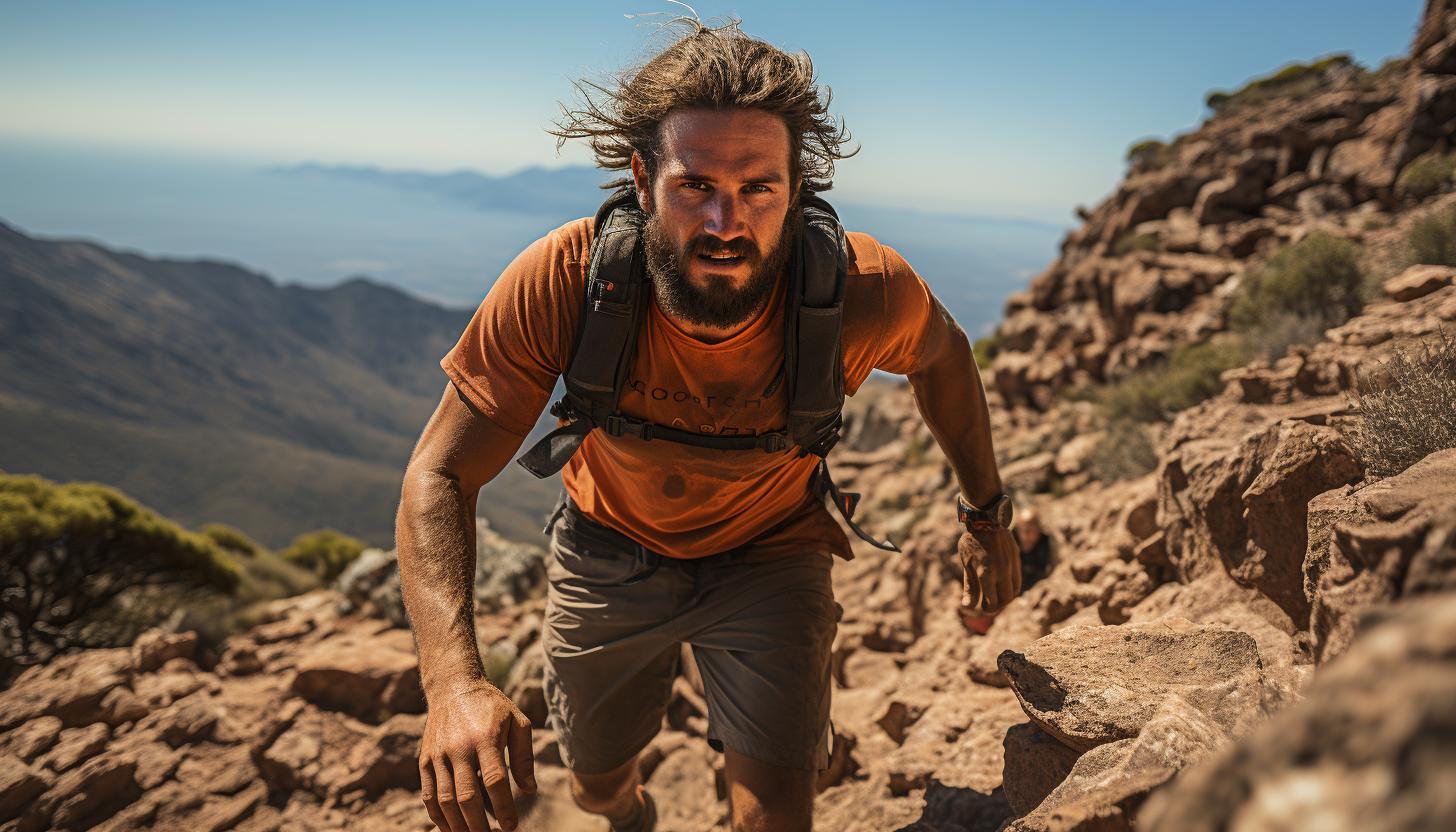Trail Running Techniques: Uphills, Downhills, and Technical Terrain

Are you ready to take your trail running skills to the next level?
Get ready to conquer the hills, navigate those downhill descents with confidence, and tackle even the most technical terrain.
In this article, we will guide you through expert techniques that will help you become a more efficient and effective trail runner.
With our knowledgeable advice and insider tips, you’ll be able to power through any challenge that comes your way.
Lace up your shoes and get ready for an exhilarating adventure!
Mastering Uphill Running

To master uphill running, you’ll need to focus on maintaining a steady pace and using your arms for added power. Uphill running can be challenging, but with the right techniques and practice, you can conquer any hill.
One important aspect of uphill running is maintaining a consistent pace. It’s tempting to sprint up the hill or slow down significantly, but neither of these approaches is ideal. Instead, try to find a pace that allows you to maintain your breathing and keep your heart rate in check. This will help you conserve energy and tackle longer climbs more efficiently.
Using your arms effectively can also make a big difference when it comes to uphill running. Your arm swing should be coordinated with your leg movements, providing additional power and momentum. Keep your elbows bent at a 90-degree angle and swing them forward and backward in sync with your stride. This will help propel you forward and upward, making those steep inclines more manageable.
Incorporating hill intervals into your training routine can also improve your uphill running abilities. Find a hilly route or use a treadmill with an incline feature. Alternate between periods of intense effort while climbing the hills and recovery periods on flat terrain or downhill sections. This type of training will not only build strength but also enhance your endurance for tackling challenging climbs.
Lastly, proper form is crucial for efficient uphill running. Maintain an upright posture with relaxed shoulders and engage your core muscles to stabilize yourself as you ascend the hill. Avoid leaning too far forward or backward as this can throw off your balance.

Maintain a relaxed posture and focus on quick, light steps when navigating downhill descents. This technique will not only improve your speed but also help in strengthening your quads. As you descend, keep your body slightly leaning forward, allowing gravity to pull you down the hill while maintaining control. Engage your core muscles to stabilize yourself and prevent any wobbling or imbalance.
As you take each step, land softly on the balls of your feet, rather than striking with your heels. This will reduce the impact on your joints and minimize the risk of injury. Your foot should roll smoothly from heel to toe as you push off for the next step.
To build strength in your quads, incorporate specific exercises into your training routine such as lunges or squats. These exercises target the muscles needed to control and stabilize yourself during downhill running.
Transitioning smoothly from downhill descents to conquering technical terrain requires adaptability and focus. In our next section, we will delve into techniques that can help you navigate challenging trails with confidence and skill.
Conquering Technical Terrain

Transitioning smoothly from conquering technical terrain requires adaptability and focus. When it comes to navigating rocky, uneven trails, balance and agility are key. Your foot placement techniques play a crucial role in maintaining stability and preventing slips or falls.
To conquer technical terrain, you need to develop a keen sense of balance. This means distributing your weight evenly and adjusting your body position as the trail changes. Keep your core engaged and your upper body relaxed but ready to react quickly to any obstacles that come your way.
When it comes to foot placement techniques, there are a few strategies you can employ. First, try to land on the balls of your feet rather than your heels. This helps absorb shock and gives you better control over each step. Additionally, widen your stance slightly for added stability and ensure that you plant each foot securely before moving on.
By mastering these balance and agility techniques along with proper foot placement, you’ll be able to navigate technical terrain more confidently and efficiently.
As you move forward in this journey of trail running techniques, effective breathing techniques will be another crucial aspect to consider. Transitioning smoothly into the next section about effective breathing techniques will help optimize your performance on both uphill climbs and downhill descents.
Effective Breathing Techniques

As you navigate through different terrains, focusing on your breathing rhythm will help optimize your performance. When it comes to trail running, effective breathing techniques are crucial for maintaining optimal pacing and mental focus.
Breathing is the fuel that keeps you going during a run. By establishing a steady and controlled breathing pattern, you can regulate your oxygen intake and carbon dioxide release more efficiently. This not only enhances your aerobic capacity but also helps prevent fatigue and muscle cramps.
To find your optimal breathing rhythm, try syncing your breaths with the cadence of your footsteps. As you climb uphill or tackle technical terrain, take deeper breaths to provide sufficient oxygen to working muscles. Conversely, when descending or running on flat surfaces, focus on exhaling fully to expel waste gases effectively.
In addition to optimizing pacing, mindful breathing can also enhance mental focus during trail runs. By consciously directing attention towards rhythmic inhalations and exhalations, distractions fade away, allowing you to stay present in the moment. This heightened awareness improves coordination and decision-making abilities while navigating tricky trails.
Remember that effective breathing techniques require practice. Incorporate specific drills into your training routine to improve lung capacity and control over time. With consistent effort and dedication, mastering the art of proper breathing will undoubtedly elevate both your physical endurance and mental resilience on the trails.
Essential Gear for Trail Running

When gearing up for a trail run, it’s essential to have the right equipment. The right gear can make all the difference in your performance and overall experience on the trails. Here are four essential items that every trail runner should have:
1. Trail Running Footwear: Invest in a good pair of trail running shoes that provide traction, stability, and protection. Look for shoes with aggressive outsoles to grip slippery surfaces, durable materials to withstand rough terrain, and cushioning to absorb impact.
2. Hydration Packs: Staying hydrated is crucial during long runs in remote areas where water sources may be scarce. A hydration pack allows you to carry water conveniently on your back while providing easy access through a hose or bite valve. Look for packs with adjustable straps for a comfortable fit and extra storage pockets for essentials like snacks and sunscreen.
3. Moisture-Wicking Clothing: Opt for moisture-wicking fabrics that will keep you dry and comfortable throughout your run. These fabrics move sweat away from your skin towards the outer surface of the clothing, allowing it to evaporate quickly.
4. Lightweight Backpack: A lightweight backpack is handy for carrying extra layers, snacks, a first aid kit, and other essentials you might need on longer runs or in unpredictable weather conditions.
Conclusion
Congratulations! You’ve now gained valuable insights into the world of trail running techniques. By mastering uphill running, navigating downhill descents, and conquering technical terrain, you’ll be well-equipped to take on any trail with confidence.
Remember to focus on your breathing techniques to maintain optimal performance throughout your run. And don’t forget about the essential gear that will keep you safe and comfortable on the trails.
Now, some may argue that trail running is too challenging or risky, but imagine the feeling of conquering those steep uphills, effortlessly gliding down the descents, and gracefully maneuvering through rugged terrain. It’s a thrilling adventure that awaits you in the beautiful wilderness.
So lace up your shoes and hit the trails – embrace the challenge and let nature be your guide!






